- GreenMatch
- Blog
- Solar panel bird-proofing in the UK
Solar Panel Bird-Proofing Full (2025) Guide

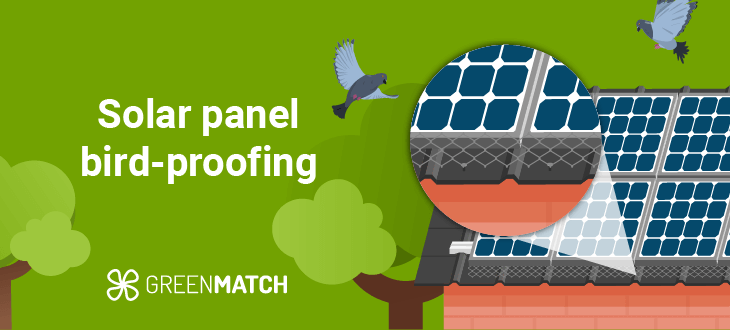
- Bird droppings and nests can reduce solar panel efficiency by up to 30%, deteriorating roofs, and provoking enduring damage, which leads to high-cost repairs.
- Bird-proofing measures, such as mesh barriers, spikes, and solar skirts, start from £50 per panel, saving homeowners thousands of pounds in possible repair and cleaning costs.
- Proper bird-proofing minimises fire risks from nesting materials, increases the panel lifespan, and lowers long-term maintenance, assuring ideal energy production and conservation for years.
With the world moving towards sustainable energy habits, solar panels have become increasingly popular in the UK, with millions of households owning them. However, they bring a challenge that is often overlooked: bird droppings and nesting.
Birds are attracted to the protected space and warmth of the solar panels, which can provoke damage with their droppings, causing energy reduction and blocking sunlight. Additionally, they can cause permanent harm due to the acidic nature of these droppings being able to destroy the panel surfaces.
In order to address these challenges, solar panel bird-proofing is necessary. It prevents birds from making their nesting homes underneath the panels, therefore, allowing for ideal energy production.
In this piece, we’ll be exploring the importance of bird-proofing and the proper measures to protect solar investments.
What is solar panel bird-proofing
Bids are drawn to solar panels since they provide them with warmth and protection. The shiny surfaces can resemble water, which calls the bird’s attention and makes them attempt to land or dive into them.
Particularly pigeons find the areas underneath the panels a suitable and safe spot for nesting, as it keeps them protected from other predators and from bad weather conditions.
Although it seems like a harmless bird habitat, it could turn into a nightmare for homeowners. The excessively acidic bird droppings can corrode panel surfaces, reducing solar efficiency by 46.42% up to 89.18% and their lifespan.
These are some of the main issues they could cause:
- Reduced efficiency: Bird dropping on solar panels forms a layer on their surface which blocks sunlight and therefore reduces the energy output of the entire connected system. Research states that even the thinnest layer of droppings can decrease sunlight absorption, lowering panel effectiveness and dropping power production up to 15% to 25%. Additionally, soiling from bird droppings could cause a percentage drop in the output power of solar PV cells by as much as 23.8%.
- Physical damage: The acidic component of bird droppings may destroy panel surfaces progressively, this could lead to permanent damage over time and provoke shortened duration for the solar panels. In addition, accumulation of droppings can erode conservative coatings on solar panels, causing long-lasting damage that reduces efficiency and lowers their lifespan.
- Increased cost of maintenance: Due to the presence of bird droppings and nesting in and on the panel, ongoing, high-maintenance efforts are required, which contribute to the overall costs of solar panel ownership. In order to keep your panels protected from pigeons, you can install a pigeon-proofing measure; the overall costs can vary from £300 to £700, based on the complexity of the installation and specific actions applied.
- Structural problems: In some situations, gutters could be clogged with accumulations of droppings and nesting substances. Other times, the roof could be ruined, leading to additional or, on occasion, serious water damage.
To avoid such issues, bird-proofing is demanded. Solutions such as mesh barriers, bird spikes, or solar skirts work effectively in deterring birds without harming them. While the upfront costs are there, these costs would be significantly less than repairing or replacing the caused damage.
Common bird species affecting solar panels
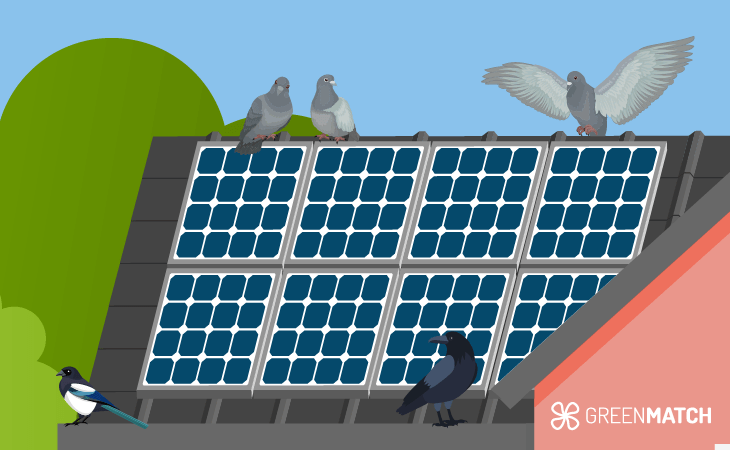
Solar panels can be under serious threat due to several bird species. Identifying those species commonly associated with solar installations and determining the effects they have on such systems is crucial for the implementation of any kind of bird-proofing measures.
The following is a full account of the most problematic bird species in the UK and the type of impact they have on solar panels.
| Bird species | Nesting issues | Droppings | Debris | Physical damage | Impact |
|---|---|---|---|---|---|
| Pigeons | Yes | Yes | Yes | Yes | Reduce efficiency by blocking sunlight with droppings, causing corrosion and nest-related fire hazards. |
| Starlings | Yes | Yes | No | No | Attract other pests and lower efficiency with their droppings. |
| Sparrows | Yes | Yes | No | No | Nests trap heat, causing panel overheating and droppings to reduce panel efficiency. |
| Jackdaws | Yes | Yes | Yes | Yes | Reduce solar panel lifespan and cause fire hazards due to their droppings and nests. |
| Seagulls | No | Yes | Yes | No | This results in corrosion and lower sunlight absorption due to accumulated droppings. |
| Blackbirds | Yes | Yes | No | No | Efficiency reduction and potential nesting issues which might obstruct airflow. |
| Magpies | Yes | Yes | Yes | Yes | Droppings and nests cause physical damage and accumulate waste. |
| Crows | Yes | Yes | Yes | Yes | Nests block ventilation, contribute to wiring damage and reduce efficiency, also due to their droppings. |
Risks of unprotected panels
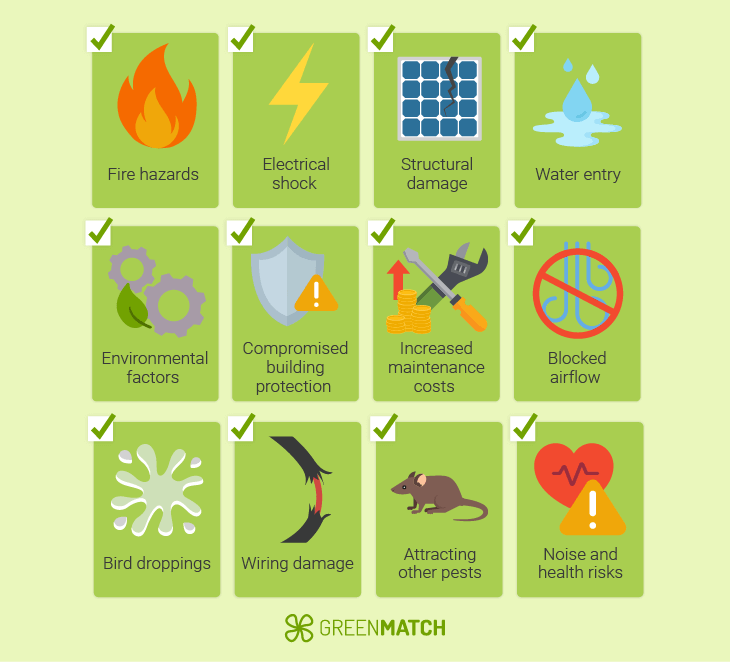
Unprotected solar panels are exposed to a diversity of challenges that might compromise their energy-efficiency, security, and lifespan. These risks include immediate physical dangers to long-term execution problems, all of which can have notable financial and dangerous outcomes for homeowners.
Comprehending these needs is necessary to implement successful protective action and ensure the solid performance of your solar panel system. The following table presents the main risks related to unprotected solar panels, the possible impact, and, lastly, suggested solutions.
| Issue | Impact | Solution |
|---|---|---|
| Fire hazards | Property damage, toxic fumes, and rapid fire spread. | Regular inspections, proper installation, and devices for bend fault protection. |
| Electrical shock | Electrocution, severe injury, or death. | Proper insulation, safety switches, and professional maintenance. |
| Structural damage | Roof damage and panel detachment during storms. | Reinforced mounting systems and professional structural assessment. |
| Water entry | Electrical faults, lower efficiency, and deterioration. | High-quality waterproof dealing and regular inspections. |
| Environmental factors | Physical damage and reduced performance. | Durable panel design, regular cleaning, and weather monitoring systems. |
| Compromised building protection | Reduced effectiveness of fire safety systems. | Integrated fire safety planning and maintaining clear access for firefighters. |
| Increased maintenance costs | Financial burden and system inefficiency, if neglected. | Scheduled maintenance plan and self-cleaning panel technologies. |
| Blocked airflow | Overheating and lower efficiency. | Install bird-proofing mesh. |
| Bird droppings | Corrosion and reduced lifespan. | Regular cleaning and proofing. |
| Wiring damage | Potential fire hazards and costly repairs. | Protect wiring with covers. |
| Attracting other pests | Infestations and additional damage. | Comprehensive pest control. |
| Noise and health risks | Disturbance and disease transmission. | Bird deterrents and proofing. |
The importance of bird-proofing
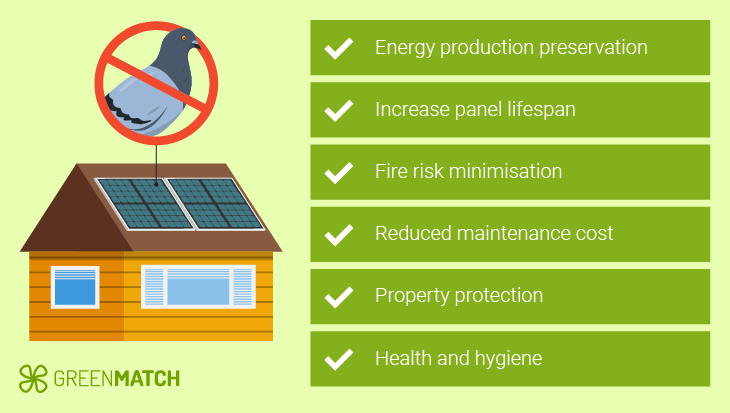
Bird-proofing not only secures and protects your solar panels from the mentioned issues but also increases their lifespan remarkably. High-quality bird-proofing solutions, like metal spikes, are as long-lasting as your solar panels, operating up to 30 years.
Correspondingly, bird-proofing your solar panels is an essential measure in order to protect your investment and ensure ideal performance for many years. The following mention key reasons why bird-proofing should be a priority.
- Energy production preservation: Bird droppings and nesting negatively affect the power generation from solar panels. By preventing birds from accessing the solar panels, you make sure they work at maximum efficiency, thereby maximising your return on investment.
- Increase panel lifespan: Overall, bird droppings are acidic, wearing away metal surfaces over time, debilitating the systematic integrity of solar panels. For this, bird-proofing helps minimise such damage and can extend the lifespan of your installation by several years.
- Fire risk minimisation: Dry nesting materials around electro-technical components are quite dangerous, with fires being a common result of this. Attentive bird-proofing will put an end to this risk.
- Reduced maintenance cost: Cleaning and repairing bird-caused issues can be very costly. For instance, the repair costs for solar panels can range from £150 to £350. In order to avoid these additional costs, bird-proofing reduces regular maintenance, so you won’t have the need to spend extra money for service.
- Property protection: Aside from birds damaging the solar panels, bird activity might also result in clogged gutters, leading to water damage and systematic issues. As well as roof damage, as birds peck at materials and can form holes for them to nest. For this, bird-proofing will safeguard the entire property from all secondary issues.
- Health and hygiene: Bird dropping may cause diseases that are dangerous to humans, such as psittacosis. Bird-proofing keeps these birds away from the panels, creating a healthy and safe environment around your residence.
Implementing appropriate bird-proofing measures is fundamental to environmental sustainability, as it strikes a balance between maximising solar energy production and protecting local wildlife.
Bird-proofing is extremely important and thereby needs to be handled with utmost care, as solar panel owners seek to protect their investments along with their long-term operational success.
Protecting your investment
The impact of birds on solar panel systems can be extremely harmful to the performance and, ultimately, the longevity of the whole system. The nesting birds may scratch and damage wiring and components, while their droppings corrode panel surfaces, resulting in a gradual reduction of efficiency.
In the UK, the average 4kW solar panel system cost is between £5,000 and £6,000, depending on the location and installer. In addition, the average regular cleaning price for solar panels starts at £150, going up to £300.
Moreover, professional bird-proofing material, such as netting or spikes, typically cost anything between £25 to £200 for a household system. This doesn’t appear to be a costly investment, especially when compared with the cost of repair, which can reach thousands of pounds.
Solar panel efficiency continuous optimisation
Bird droppings and debris significantly impact energy generation. Even small obstructions reduce sunlight absorption, reducing overall output. Clean unobstructed panels can generate up to 30% more electricity than soiled ones. Regular cleaning and bird-proofing annually are crucial to maximise your home’s energy efficiency.
Avoiding bird issues guarantees your solar panels are operating at their maximum capacity, providing you with the highest return on investment and contributing towards a cleaner energy future.
| Obstruction level | Energy production loss | Description |
|---|---|---|
| Light | 5% to 10% | Minor soiling (Such as dust, pollen, or occasional bird droppings). |
| Moderate | 15% to 25% | Accumulation of debris, leaves, or multiple bird droppings covering key areas. |
| Heavy | 30% to 50% | Extensive coverage from bird nests, heavy droppings, or significant shading. |
Types of solar panel bird-proofing
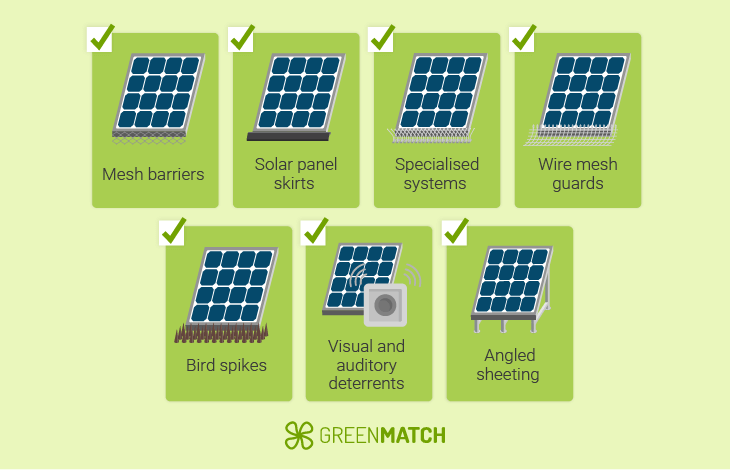
Without proper precautions, birds can cause extensive damage to your solar panels. To avoid these issues, let’s explore the different types of solar panel bird-proofing.
| Method | Description | Effectiveness | Suitability |
|---|---|---|---|
| Mesh barriers | UV-stabilised mesh barriers prevent birds from nesting in the underneath area. | High: Their durability and secure installation make them a long-lasting solution for most bird species. | The majority of residential installations. |
| Solar panel skirts | Heavy-duty metal barriers that don't allow birds to penetrate. | High: This strong method creates a flawless barrier, preventing bird access with no gasps. | Best choice for a more aesthetic appeal. |
| Specialised systems | Employ clips and corner pieces to form a protective perimeter around solar panels. | High: Customized solutions assuring an easy fit and complete protection. Durable and efficient bird control by avoiding nesting and roosting. | Balances functionality and aesthetics. |
| Wire mesh guards | Heavy-duty wire mesh with PVC layer, mounted on universal clips, creating a successful bird barrier. | High: Offer long-lasting durability, creating a powerful barrier that prevents bird access, and are highly effective in areas with persistent bird issues. | Optimal for persistent bird issues. |
| Bird spikes | Stainless steel spikes on solar panels edges create an uncomfortable landing surface for birds. | Medium to high: Their main focus is to deter landing, however smaller birds might nest in gaps, lowering long-term efficiency. | Effective for bigger/larger birds. |
| Visual and auditory deterrents | Reflective tape, decoys, or ultrasonic devices emit bird-unpleasant sounds inaudible to humans. | Low to medium: These methods scare birds away, but lose effectiveness over time as they may adapt, working best combined with other barriers. | Best as supplementary measures. |
| Angled sheeting | Angling panels create a sliding surface that prevents birds from landing. | Low to medium: This measure can deter some birds, but smaller ones might still land or nest, and it’s less successful against persistent species. | Works less effectively against smaller birds. |
These methods are intended to scare birds away from nesting on solar panels without causing harm, that way, your solar system can function safely and adequately. The choice of method could also depend on the local bird species and the solar panel installation.
Bird-proofing solar panels across the UK regions
Bird-proofing solar panels is an essential procedure for their long-term durability and efficiency across the UK. The various regions are susceptible to different challenges based on local bird populations and climate conditions, impacting the need for proper bird-proofing solutions.
Here is an overview of the requirements involved in bird-proofing across regions in the UK.
| Region | Most common bird species | Estimated number of affected sites | Description |
|---|---|---|---|
| Scotland | Gulls and pigeons | 150 | Higher demand in rural areas that have greater solar installations. |
| Northern England | Starlings | 120 | Increasing installations in urban and semi-rural locations. |
| Midlands | Jackdaws and rooks | 100 | Due to their diverse habitats, solar farms often attract birds. |
| Southern England | Sparrows and blackbirds | 200 | The highest number of installations since central areas face pigeon problems. |
| Wales | Magpies and crows | 80 | Solar panel adoption is dominated by rural regions. |
| Northern Ireland | Swallows and house martins | 60 | Bird interference in smaller-scale installations. |
Costs of solar panel bird-proofing in the UK
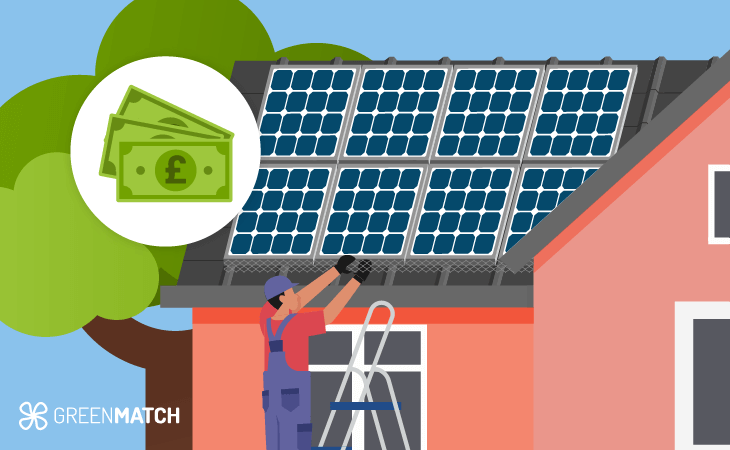
In the UK, there are over 1.4 million households that have installed solar panels. For that reason, it’s highly required to protect your solar energy systems from potential damage that can be easily caused by bird nestings and droppings.
The costs to install bird-proofing into your solar panels depends on your system proportions, roof accessibility, and chosen method of installation. Generally, the prices for basic bird-proofing in the UK start at roughly £50 per panel. The following table summarises the estimated costs for bird-proofing solar panels based on a 430W system size.
| System size (kilowatt-peak) | Number of panels (430W) | Estimated bird-proofing cost |
|---|---|---|
| 2kWp | 5 | £250 |
| 3kWp | 7 | £350 |
| 4kWp | 10 | £500 |
| 5kWp | 12 | £600 |
Moreover, the prices also base on the type of bird-proofing used. The following table illustrates the estimated costs for the different measures designed to keep your solar panels safe from bird nestings and droppings.
Other types of measures, like anti-roosting, offer a price of £25, and bird netting, a price ranging from £150 to £200.
| Bird-proofing method | Cost range |
|---|---|
| Mesh barriers | The most common and efficient method. A roll of bird mesh has a cost range from £50 to £100 per meter. |
| Solar panel skirts | Specific prices are not specific. However, these costs tend to vary on multiple factors, such as size and shape, location, and accessibility to your roof. |
| Specialised systems | Bills range widely based on the complexity and brand. However, they’re often more expensive than mesh barriers. |
| Wire mesh guards | The usual cost of wires varies on the length needed and the material that's been used. You can predict spending from £10 to £30. |
| Bird spikes | Varies on the number of panels you own and the quality of the spikes. Typically, the price ranges from £100 to £400 with the installation included. |
| Visual and auditory deterrents | The price of ultrasonic devices changes depending on the number of panels you have and the quality of the device. On average, the costs range between £100 and £300. |
| Angled sheeting | Although exact costs aren’t available, angled sheeting can cut expenses by eliminating bird-proofing materials, but might add installation bills. |
Furthermore, there might be additional costs to be considered. Labour costs, including installation and maintenance, can range from £220 up to £300 per day. Additionally, you might encounter cost variations. These can be minor repairs that may cost a few hundred pounds, or major harm, like displaced electrical components, that are priced from £500 to £1000.
It’s worth mentioning that remodelling your solar panels to add bird-proofing is more costly than installing them during the initial solar system installation. For that reason, professional instalment is recommended for ideal protection, a lengthy lifespan, and long-term savings.
Securing your solar investment: Key steps to follow for solar panel bird-proofing
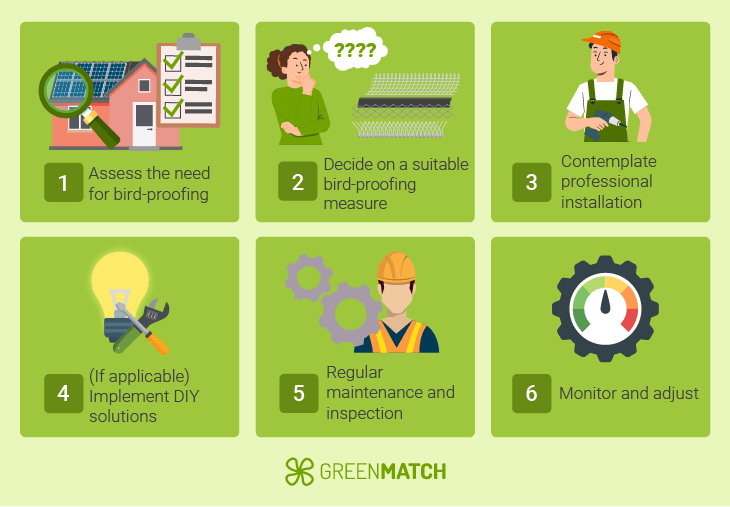
If you’re ready to invest in solar power and gain the rewards of clean, renewable energy, integrating bird-proofing into your home is an intelligent action. Bird nestings and droppings can outstandingly negatively influence the ability of your panels, lowering your energy development and potential savings.
If you want to move forward with the installation, you should consider the following steps.
1. Assess the need for bird-proofing
Determine if you have a bird issue affecting your solar panels. Search for indications of nesting, droppings, and debris on or in the surroundings of the panels. Additionally, contemplate the common bird species in your area and the possibility of their impact on your solar panels (e.g. pigeons, sparrows, etc.).
2. Decide on a suitable bird-proofing measure
Selecting the correct bird-proofing measure varies on your specific needs, the birds in your local area, and the design of your solar panels. In the case you go for mesh barriers, solar panel skirts, bird spikes, or other alternatives, each method provides distinctive advantages to ensure your solar panels remain safe and systematic. Assessing your environment and the amount of bird activity will guide you to the most efficient and ecological options for your solar panels.
3. Contemplate professional installation
Professional installers provide notable benefits in making certain that bird-proofing is done accurately, augmenting its effectiveness and lifespan. Specialists can supply comprehensive services that include cleaning, nest removal, biocide treatment, and mesh installation, frequently along with guarantees. Choosing expert installation can also help prevent voiding panel warranties, offering added serenity.
4. (If applicable) Implement DIY solutions
For DIY enthusiasts, the use of high-quality materials, such as durable mesh and clips, is essential. It’s fundamental to follow installation orders attentively to ensure proper attraction and full allowance. Nonetheless, keep in mind that DIY solutions might feel the absence of the offered guarantees by professionals, and any errors could result in ongoing issues or reduced effectiveness.
5. Regular maintenance and inspection
Whether you work with experts or DIY the installation measurements, regular maintenance is crucial to the long-term success of your bird-proofing efforts. This includes regularly cleaning and examining your solar panels to ensure they endure in optimal condition. Make sure to look for gaps or damage in the bird-proofing materials and make decisive repairs immediately.
6. Monitor and adjust
After executing your chosen bird-proofing measures, it’s essential to control their effectiveness. If birds continue to cause problems, you may consider adding supplementary deterrents or consulting with an expert for further outcomes. Flexibility and versatility are significantly important to achieve desired solutions.
FAQs
To protect your solar panels from birds, you could consider implementing one of the following measures. You could install mesh barriers, solar panel skirts, bird spikes, visual and auditory deterrents, angled sheeting, specialised systems, or wire mesh guards. You decide which one suits your solar panels best depending on the issue you’re encountering.
You most likely need bird-proofing if you own solar panels and notice signs of bird nesting, droppings, or debris on them or around them. If your solar panels are unprotected, they can create an artificial environment for birds.
Regular maintenance is essential to get rid of bird droppings and any other stains your solar panel might have. In the case of droppings, wipe the panels softly with a brush or cloth and mild soapy water. Make sure to avoid harsh chemicals that could potentially harm the panel surface.
The cost of bird-proofing usually starts at roughly £50 per panel. Therefore, the overall costs can vary from £300 to £700, based on the complexity of the installation and specific methods used.

Carmen is a writer at GreenMatch who has a strong interest in renewable energy and finds purpose in educating others on sustainable practices that will help create a more environmentally friendly future. Her attention to detail and dedication to accuracy ensure that every piece is reliable and helpful.
We strive to connect our customers with the right product and supplier. Would you like to be part of GreenMatch?

Stay up to date with energy saving tips and grant alerts
Receive offers, marketing and promotions via email from Leads.io about GreenMatch and our brands/partners to help you save.
Thank you for subscribing to our newsletter!
Your email has been successfully added to our list. We look forward to sharing our latest updates with you soon!
